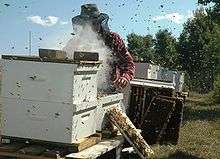Apitherapy
Apitherapy is a branch of alternative medicine that uses honey bee products including honey, pollen, bee bread, propolis, royal jelly and bee venom.
Proponents of apitherapy make many wide-ranging claims for its health benefits which are not supported by medical evidence.[1][2]
History
The more modern study of apitherapy, specifically bee venom, was initiated through the efforts of Austrian physician Phillip Terc in his published results "Report about a Peculiar Connection Between the Bee stings and Rheumatism" in 1888. More recent popularity can be drawn to Charles Mraz (1905–1999), a beekeeper from Vermont, United States over the past 60 years.[3]
Health claims
Apitherapy is widely promoted as having a wide range of health benefits, including the ability to treat multiple sclerosis, to alleviate various types of pain, and to boost general wellbeing.[2] Such claims are not supported by medical evidence.[2] There is evidence apitherapy may worsen the course of multiple sclerosis.[4]
Although honey and its derivative products are under investigation for possible medical applications in cancer therapy there are, according to the American Cancer Society, "no clinical studies in humans showing that bee venom or other honeybee products are effective in preventing or treating cancer."[1]
See also
References
- 1 2 Ades TB, ed. (2009). "Apitherapy". American Cancer Society Complete Guide to Complementary and Alternative Cancer Therapies (2nd ed.). American Cancer Society. pp. 704–708. ISBN 9780944235713.
- 1 2 3 Cassileth BR (2011). The Complete Guide to Complementary Therapies in Cancer Care: Essential Information for Patients, Survivors and Health Professionals. World Scientific. pp. 221–. ISBN 978-981-4335-66-9.
- ↑ "History of Apitherapy". Medicineworld.org. Retrieved 31 August 2016.
- ↑ "Bee Venom Therapy – Grassroots Medicine". Science-Based Medicine. Retrieved 28 September 2016.
Further reading
- Bee Venom Therapy – By Steven Novella MD, President of the New England Skeptical Society
